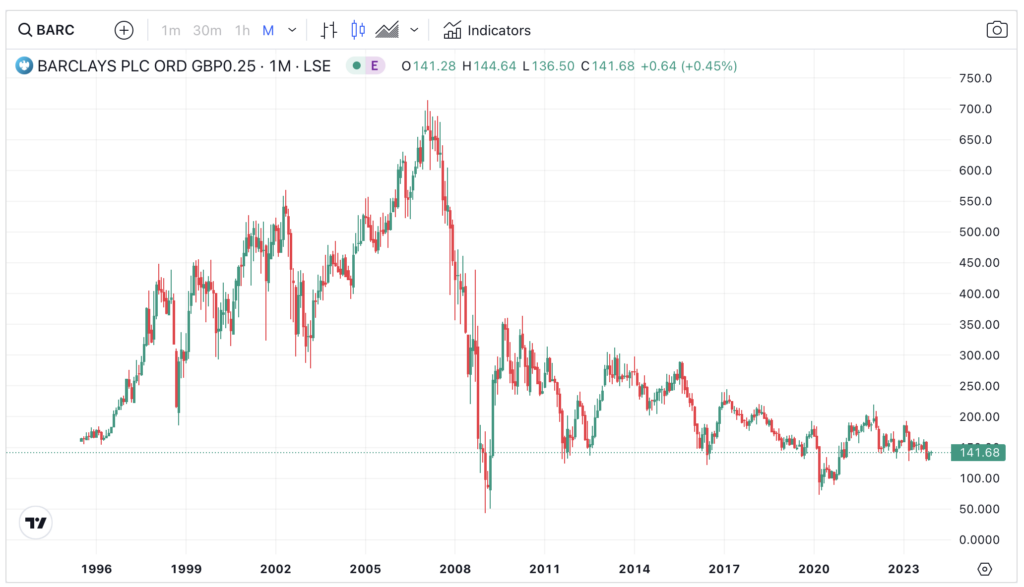Barclays’ share price chart says it all. Despite surviving the 2008 financial crisis, Barclays has not really recovered its spirit and the share price is still dropping. So why the sell-off?
Each time the share rallied Barclays peaked then registered a ‘lower high’. This pattern has sustained for over a decade (a secular downtrend, really). In October 2009, for instance, Barclays rebounded to a high of 350p. Now Barclays shares trade at less than half of that.
Even the post-pandemic rally share price peaked at 210p momentarily. So what went wrong for Barclays, the once-admired investment bank?
Why Barclays’ share price is falling
For one, investors aren’t really interested in UK banking stocks. These days, the Big Three UK banks (Barclays, Lloyds, Natwest) are mostly domestic focussed banks. While banking earnings are stable, the background risk is mounting. Property prices and income growth are vulnerable to a dip as interest rate stayed high. In early December, UK October GDP came in below expectations.
Moreover, even Barclay’s long-term cornerstone shareholder – Qatar Holding – is selling out. This heaps further downward pressure on Barclays’ share price.
Following Barclay’s worst-than-expected third-quarter results (in which 3Q attributable profits down 16 percent), its share price slumped to a multi-year low.
Valuation for the UK bank is now among the cheapest in the industry. At £21.5 billion (Dec ’23), Barclays’ market cap is only 5.8 percent of JP Morgan’s.

What can turn around Barclays shares?
Barclays is a unique UK bank. It has a large card business (Barclays Card), a not-insubstantial investment bank, and a considerable commercial and mortgage loan business.
The problem with the Barclays share price is this: Barclays is not a clear leader in any of these businesses. The prestigious global investment banking business is now dominated by American banks. Barclays has no presence in wealth management (sold BGI for a song during the GFC). Lloyds is the largest UK mortgage provider.
Barclays Group needs to prove that it can generate further earnings in a more predictable fashion. Remember, investmet banking is a volatile business unit.
Lastly, of course, the country’s macro environment has to improve to boost investor sentiment.
Outlook
For now, Barclays risks sliding further down into the 120p-100p region. However, that area has proved to be a source of support over the years. Perhaps patient long-term investors should look to accumulate around that floor.

Jackson is a core part of the editorial team at GoodMoneyGuide.com.
With over 15 years of industry experience as a financial analyst, he brings a wealth of knowledge and expertise to our content and readers.
Previously, Jackson was the director of Stockcube Research as Head of Investors Intelligence. This pivotal role involved providing market timing advice and research to some of the world’s largest institutions and hedge funds.
Jackson brings a huge amount of expertise in areas as diverse as global macroeconomic investment strategy, statistical backtesting, asset allocation, and cross-asset research.
Jackson has a PhD in Finance from Durham University and has authored over 200 guides for GoodMoneyGuide.com.
To contact Jackson, please ask a question in our financial discussion forum.

